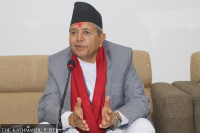National
Allocation for Nepal decreases by 33 percent in India’s budget
Nepal to receive Rs 12.8 billion in aid from its southern neighbour in the next fiscal year.Prithvi Man Shrestha
India has substantially decreased its aid to Nepal for fiscal year 2020-21 in the budget presented by Indian Finance Minister Nirmala Sitharaman, on Saturday.
According to the budget speech, the southern neighbour allocated INR8 billion (Rs12.8 billion) for Nepal. In the fiscal year 2019-20, India had allocated INR10.5 billion (Rs16.8 billion), which was later revised to INR12 billion (Rs19.2 billion).
Based on the revised allocation of fiscal year 2019-20, allocation in the new fiscal year has been cut down by 33 percent.
Despite a decline in the budgetary allocation for Nepal, it is still the recipient of the second largest aid allocation after Bhutan, traditionally the largest aid recipient from India. India set aside INR28.84 billion for Bhutan. Afghanistan, Maldives, Bangladesh and Sri Lanka are the other South Asian nations that will receive Indian aid.
The Southern neighbour has been allocating its second largest aid to Nepal since fiscal year 2017-18. Earlier, Afghanistan was the second largest recipient from the Indian budgetary allocation.
Although India has been allocating budget for Nepal, the Nepal government does not have data about how the amount is being spent.
“India provides the allocated amount as a grant for various projects. But the amount does not come through the national budgetary system of Nepal,” a senior official of the Finance Ministry told the Post on the condition of anonymity because he is not authorised to speak to the media. “Most of the amount is spent in direct payments by the Indian government to the contractors.”
However, the government has made an effort to bring parts of the Indian aid in Nepal’s budgetary system. India’s Small Development Grant Project will now be disbursed to local governments after it comes under the budgetary system.
The Sher Bahadur Deuba-led government in November 2017 extended the tenure of the scheme with the caveat that the funds pass through Nepal’s national system with the Nepal government getting to decide which agency implements the project. The government’s decision to follow the constitutional provisions which state that any foreign assistance should be channelised through the national budget is aimed to ensure transparency.
The Cabinet on December 23 last year, approved a proposal of the Finance Ministry on the implementation of the projects under the scheme. As per the proposal, the Indian grants will be brought under the budgetary system of the central government to be provided to the local governments as conditional grants.
Nepal has also been receiving Indian aid through another window of the Indian government—concessional loans from the Export-Import Bank of India.
The southern neighbour has agreed to provide four lines of credit to Nepal amounting to $100 million, $250 million, $550 million and $750 million, according to the Indian Embassy website.
These lines of credit were signed in June 2006, September 2007 and September 2016 for execution of infrastructure development projects and post-earthquake reconstruction projects as prioritised by the Nepal government. “Approximately $1 billion out of the four lines of credit have been committed or disbursed,” the embassy said.




 7.12°C Kathmandu
7.12°C Kathmandu















